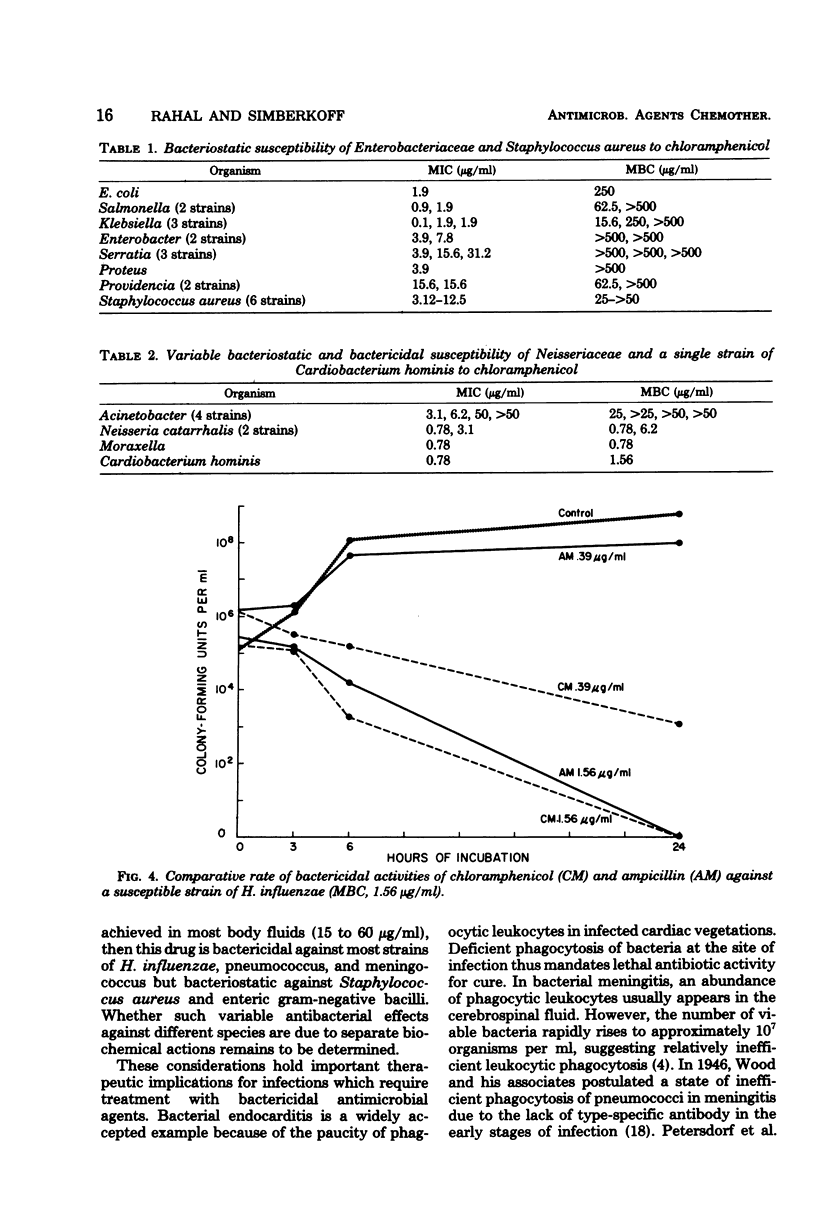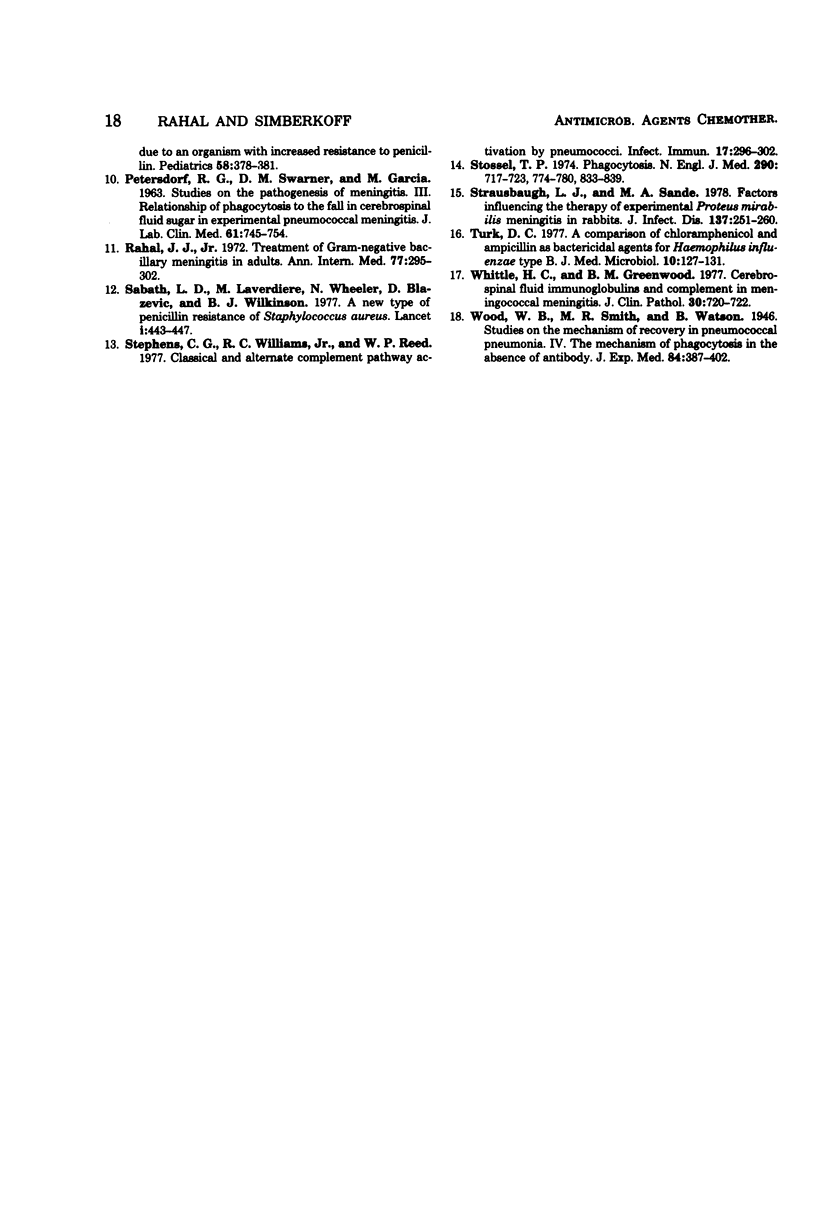Abstract
The bacteriostatic and bactericidal effects of chloramphenicol, ampicillin, tetracycline, and sulfisoxazole were compared against several potential meningeal pathogens. Chloramphenicol is bactericidal at clinically achievable concentrations against Haemophilus influenzae, Streptococcus pneumoniae, and Neisseria meningitidis. It is bacteriostatic against gram-negative bacilli of the family Enterobacteriaceae and against Staphylococcus aureus. Chloramphenicol has proven highly efficacious in the treatment of bacterial meningitis caused by those organisms against which it is bactericidal at low concentrations. Because leukocytic phagocytosis in the subarachnoid space is inefficient, we propose that bactericidal activity in cerebrospinal fluid is important for optimal therapy of bacterial meningitis. Chloramphenicol does not provide such activity in meningitis caused by enteric gram-negative bacilli.
Full text
PDF





Selected References
These references are in PubMed. This may not be the complete list of references from this article.
- Alexander H. E., Leidy G., Redman W. COMPARISON OF THE ACTION OF STREPTOMYCIN, POLYMYXIN B, AUREOMYCIN AND CHLOROMYCETIN ON H. PERTUSSIS, H. PARAPERTUSSIS, H. INFLUENZAE AND FIVE ENTERIC STRAINS OF GRAM-NEGATIVE BACILLI. J Clin Invest. 1949 Sep;28(5 Pt 1):867–870. doi: 10.1172/JCI102170. [DOI] [PMC free article] [PubMed] [Google Scholar]
- Brotherton T., Lees T., Feigin R. D. Susceptibility of Haemophilus influenzae type b to cefatrizine, ampicillin, and chloramphenicol. Antimicrob Agents Chemother. 1976 Aug;10(2):322–324. doi: 10.1128/aac.10.2.322. [DOI] [PMC free article] [PubMed] [Google Scholar]
- Cova J. L., Propp R. P., Barron K. D. Quantitative relationships of the fourth complement component in human cerebrospinal fluid. J Lab Clin Med. 1977 Mar;89(3):615–621. [PubMed] [Google Scholar]
- Feldman W. E. Effect of ampicillin and chloramphenicol against Haemophilus influenzae. Pediatrics. 1978 Mar;61(3):406–409. doi: 10.1542/peds.61.3.406. [DOI] [PubMed] [Google Scholar]
- Feldman W. E. Relation of concentrations of bacteria and bacterial antigen in cerebrospinal fluid to prognosis in patients with bacterial meningitis. N Engl J Med. 1977 Feb 24;296(8):433–435. doi: 10.1056/NEJM197702242960806. [DOI] [PubMed] [Google Scholar]
- Mangi R. J., Quintiliani R., Andriole V. T. Gram-negative bacillary meningitis. Am J Med. 1975 Dec;59(6):829–836. doi: 10.1016/0002-9343(75)90468-4. [DOI] [PubMed] [Google Scholar]
- O'Toole R. D., Thornton G. F., Mukherjee M. K., Neogy K. N. Cerebrospinal fluid immunoglobulins in bacterial meningitis. A possible role for antibody in pneumococcal meningitis. Arch Neurol. 1971 Sep;25(3):218–224. doi: 10.1001/archneur.1971.00490030044004. [DOI] [PubMed] [Google Scholar]
- PETERSDORF R. G., SWARNER D. M., GARCIA M. Studies on the pathogenesis of meningitis. III. Relationship of phagocytosis to the fall in cerebrospinal fluid sugar in experimental pneumococcal meningitis. J Lab Clin Med. 1963 May;61:745–754. [PubMed] [Google Scholar]
- Paredes A., Taber L. H., Yow M. D., Clark D., Nathan W. Prolonged pneumococcal meningitis due to an organism with increased resistance to penicillin. Pediatrics. 1976 Sep;58(3):378–381. [PubMed] [Google Scholar]
- Rahal J. J., Jr Treatment of gram-negative bacillary meningitis in adults. Ann Intern Med. 1972 Aug;77(2):295–302. doi: 10.7326/0003-4819-77-2-295. [DOI] [PubMed] [Google Scholar]
- Sabath L. D., Wheeler N., Laverdiere M., Blazevic D., Wilkinson B. J. A new type of penicillin resistance of Staphylococcus aureus. Lancet. 1977 Feb 26;1(8009):443–447. doi: 10.1016/s0140-6736(77)91941-9. [DOI] [PubMed] [Google Scholar]
- Stephens C. G., Williams R. C., Jr, Reed W. P. Classical and alternative complement pathway activation by pneumococci. Infect Immun. 1977 Aug;17(2):296–302. doi: 10.1128/iai.17.2.296-302.1977. [DOI] [PMC free article] [PubMed] [Google Scholar]
- Stossel T. P. Phagocytosis (third of three parts). N Engl J Med. 1974 Apr 11;290(15):833–839. doi: 10.1056/NEJM197404112901506. [DOI] [PubMed] [Google Scholar]
- Strausbaugh L. J., Sande M. A. Factors influencing the therapy of experimental Proteus mirabilis meningitis in rabbits. J Infect Dis. 1978 Mar;137(3):251–260. doi: 10.1093/infdis/137.3.251. [DOI] [PubMed] [Google Scholar]
- Turk D. C. A comparison of chloramphenicol and ampicillin as bactericidal agents for Haemophilus influenzae type B. J Med Microbiol. 1977 Feb;10(1):127–131. doi: 10.1099/00222615-10-1-127. [DOI] [PubMed] [Google Scholar]
- Whittle H. C., Greenwood B. M. Cerebrospinal fluid immunoglobulins and complement in meningococcal meningitis. J Clin Pathol. 1977 Aug;30(8):720–722. doi: 10.1136/jcp.30.8.720. [DOI] [PMC free article] [PubMed] [Google Scholar]


